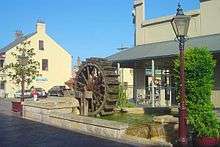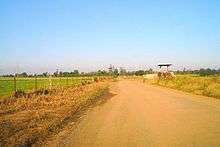Windsor, New South Wales
| Windsor Sydney, New South Wales | |||||||||||||
|---|---|---|---|---|---|---|---|---|---|---|---|---|---|
 The historic Tebbutt's Observatory (c. 1879) | |||||||||||||
 Windsor | |||||||||||||
| Coordinates | 33°36′54″S 150°49′02″E / 33.61500°S 150.81722°ECoordinates: 33°36′54″S 150°49′02″E / 33.61500°S 150.81722°E | ||||||||||||
| Population | 1,803 (2011 census)[1] | ||||||||||||
| Established | 1810 | ||||||||||||
| Postcode(s) | 2756 | ||||||||||||
| Location | 56 km (35 mi) north-west of Sydney CBD | ||||||||||||
| LGA(s) | City of Hawkesbury | ||||||||||||
| State electorate(s) | Hawkesbury | ||||||||||||
| Federal Division(s) | Macquarie | ||||||||||||
| |||||||||||||



Windsor is a town lying west of Sydney, New South Wales, Australia. Windsor is located in the local government area of the City of Hawkesbury. It sits on the Hawkesbury River, on the north-western outskirts of the Sydney metropolitan area. At the 2011 census, Windsor had a population of 1,803.[1]
History
Windsor is the third-oldest place of British settlement on the Australian continent. Settlement at the location was first established about 1791, near the head of navigation on the Hawkesbury River (known as Deerubbin in Dharuk) and taking advantage of the fertile river flats for agriculture. The area was originally called Green Hills, but renamed Windsor (after Windsor in England). The town was officially proclaimed in a Government and General Order issued from Government House, Sydney, dated 15 December 1810, Governor Lachlan Macquarie having "marked out the district of Green Hills", which he "... called Windsor", after Windsor-on-the-Thames.
While in Windsor, Macquarie ordered the main institutions of organised settlement to be erected, such as a church, school-house, gaol and "commodious inn" (The Macquarie Arms). Of these new buildings, the most outstanding was Francis Greenway's Saint Matthew's Anglican Church, for which Macquarie himself chose the site. Samuel Marsden, principal chaplain of the colony, consecrated the church on 8 December 1822.[2]
In 1813 a report was given to Governor Macquarie from Earl Bathurst detailing a proposed invasion of the Hawkesbury River by France.[3] This planned invasion that did not eventuate, targeted the Windsor granary in order to cut off supply to Sydney, showing the relative importance of this new settlement on a global scale.
Windsor is approximately 60 kilometres north-west of Sydney, and the location was chosen because of the agricultural potential of the area and the location was accessible by coastal shipping from Sydney. It was known as the "bread basket", ensuring the survival of the starving colony. The extensive agriculture caused major silting in the Hawkesbury River, by the 1890s the river had become so blocked with silt, ships could not travel up to Windsor from the coast. By then the railway, in 1864, and the road, in 1814, had been built.
On 1 January 1803 Daniel Egan was born in Windsor. He went on to become Mayor of Sydney in 1853. Many of the oldest surviving European buildings in Australia are located at Windsor.
Heritage
The following buildings are listed on the Register of the National Estate.[4]
- St Matthew's Anglican Church, Cemetery and Rectory, 1817–20
- Toll House, Bridge Street, c. 1835
- Claremont Cottage, Claremont Crescent, c. 1822
- Court House, Court Street, 1821
- Fairfield House, Fairfield Avenue, c. 1831
- Sunny Brae, Kable Street, 1875
- Cope House Group, George Street, c. 1835–1880
- George Street Inn Group, George Street, c. 1830–1841
- Public School, George and Dight Streets, 1869
- Loder House, George Street, 1834
- Johnston Street Group, 21–27 Johnston Street, c. 1840
- Former Bell Inn, Little Church Street, c. 1841
- Two Terraced Houses, 2–4 Catherine Street, c. 1840
- Two Terraced Houses, 5–7 Catherine Street, c. 1840
- Two Terraced Houses, 1–3 Little Church Street, c. 1840
- Tebbutt's Observatory and House, Palmer Street, 1844–79
- Group of Houses, 23–39 North Street, 28 North Street, c. 1840–1875
- Thompson Square Precinct and Bridge Street Buildings, including Hawkesbury Museum, c. 1830–1861
- Macquarie Arms Hotel, Thompson Square, built 1815[5]
- Crescentville, 80 The Terrace, 1851
- The Doctor's House, 1–3 Thompson Square, 1830
Geography
Floods are a major concern in Windsor. Its proximity to the Hawkesbury River has resulted in numerous disastrous floods. A horseshoe on the outside wall of the Macquarie Arms pub marks the level the flood peaked at in 1867, when beaches along the Hawkesbury to Barrenjoey were littered with the debris from the town.
Transport
The spread of the suburbs of metropolitan Sydney has almost reached Windsor, and the town is now regarded as an outer suburb, though still retaining its appeal as a small country town. Windsor railway station (opened 1 December 1864[6]), is on the Richmond branch of the North Shore, Northern & Western Line of the Sydney Trains network.
Located in the town centre is the Windsor Bridge, constructed in 1874, is the oldest existing crossing of the Hawkesbury River.[7]
Media
The studios of local community radio station Hawkesbury Radio are located in Windsor. Windsor was also a filming location for the Channel 7 television series A Country Practice and its fictional town of Wandin Valley, including being the location of the Wandin Valley doctors clinic. Windsor High School was also used as the fictional Burrigan High School in the series
-

Home made of sandstock bricks
-

St Matthew's Anglican Church, designed by Francis Greenway
-

St Matthew's, interior
-

Hawkesbury River at Windsor
See also
- Dillwynia Women's Correctional Centre
- John Morony Correctional Centre
- Windsor Wolves
- Richmond, New South Wales
References
- 1 2 Australian Bureau of Statistics (31 October 2012). "Windsor (State Suburb)". 2011 Census QuickStats. Retrieved 2 August 2015.
- ↑ Baker, Helen (1967). Historic Buildings. Windsor and Richmond (1st ed.). The State Planning Authority of New South Wales.
- ↑ http://www.hawkesburyhistory.org.au/stubbs/french.html
- ↑ The Heritage of Australia, Macmillan Group, 1981, pp.2/124-129
- ↑ "History". Macquarie Arms. 2013-08-13. Retrieved 2014-06-04.
- ↑ Station Names. Date of opening, closing and/or change of name. Public Transport Commission of New South Wales. Administrative Branch (Archives Section) (3rd ed.). February 1979 [1965]. p. 37.
- ↑ Liz Foschia (4 Dec 2013). "NSW Premier's office accused of political interference in Windsor Bridge approval". ABC. Retrieved 15 January 2015.